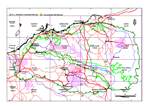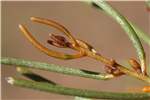Click on images
to enlarge



Photographer: B.R. Maslin

Photographer: B.R. Maslin

Photographer: B.R. Maslin

Photographer: B.R. Maslin

Photographer: B.R. Maslin

Photographer: B.R. Maslin

Photographer: R. Rutishauser
, BRM 7332, FM_sml.jpg)
Seed from one herbarium voucher. Scale in mm. Photographer: F. McCallum
Botanical name
Acacia aneura var. macrocarpa Randell, J. Adelaide Bot. Gard. 14: 121 (1992)
Common name
Mulga
Note
Acacia aneura and related species form a very complex and polymorphic assemblage of taxa with A. aneura itself the most variable (see Miller et al. 2002 for discussion). These species are currently under review therefore the classification here of Pilbara entities referable to A. aneura is provisional. Currently 10 varieties are recognized within A. aneura (Pedley 2001) of which six appear to occur in the Pilbara. These varieties encompass most of the variation in Mulga in the Pilbara and are the entities upon which this Wattles of the Pilbara treatment of Mulga is based. It is often difficult to distinguish between the varieties, and between A. aneura and related species (especially A. ayersiana and A. paraneura) on account of seemingly intermediate forms. In past literature it is often not possible to know to which of the varieties the information applies. Therefore, we have assembled these data under the heading of A. aneura. The data presented below for A. aneura var. macrocarpa is derived from our field and herbarium studies of only the Pilbara plants of this entity.
Description
Spreading shrubs 2-4 (-6) m tall, the stems gnarled and twisted. Branchlets obscurely ribbed at extremities, ribs covered with a thin layer of translucent resin, minutely appressed-hairy but soon glabrous. New shoots normally light to mid-brown at initiation often drying dark brown. Phyllodes terete, 50-100 mm long, 1 mm in diameter, curved (often strongly so) to sigmoid, green; longitudinal nerves numerous, fine and close together. Gland (0-) 2-10 mm above the pulvinus, phyllode swollen and often slightly kinked at the gland. Spikes 10-20 mm long (judging from fruiting receptacle length); peduncles 8-15 mm long. Flowers not seen. Pods oblong (20-) 50-70 mm long, 16-22 mm wide, thinly coriaceous, finely transversely reticulate (nerves often obscured by resin), ±glabrous, light brown to yellow-brown; marginal nerve thickened but wing absent or very rudimentary. Seeds (immature) transverse in pods, (6-) 7-9 mm long and 5.5-7.5 mm wide in plants outside the Pilbara.
Distribution and ecology
Variety macrocarpa is seemingly rare in the Pilbara where it is known from near West Angelas in the central Hamersley Range and on Hillside Station, just north of the Fortescue River. Grows in red clay-loam on stony gibber plains in low lying areas near shallow drainage lines. The overall range of var. macrocarpa is given by Pedley (2001) as being scattered in the Mulga zone of Western Australia and also from far northwest South Australia.
Flowering and fruiting period
Flowering specimens from the Pilbara are unknown. Pods with immature seeds have been collected in mid-July and it is estimated that they would reach maturity in August/September.
Affinities
The terete, strongly incurved or sigmoid phyllodes which are clearly swollen about the gland, and the very wide pods which are not (or scarcely) winged distinguishes this variety from all others within A. aneura. In the absence of pods however, some plants of var. macrocarpa could perhaps be confused with var. pilbarana; a combinations of phyllode characteristics (as described above) as well as growth form (variety macrocarpa grows as spreading shrubs, whereas variety pilbarana matures into obconic trees) can be used to separate these two varieties.
Conservation status
Although apparently uncommon in the Pilbara this variety is relatively common in more southerly regions and is therefore not considered rare or endangered.
Origin of name
The varietal name is derived from the Greek macro- (large) and carpos (fruit) referring to the conspicuously larger fruit than in the typical variety.
References
Miller, J.T., Andrew, R.A. and Maslin, B.R. (2002). Towards an understanding of variation in the Mulga complex (Acacia aneura and relatives). Conservation Science Western Australia 4(3): 19-35.
Pedley, L. (2001). Acacia aneura. pp. 314-322. In: A.E. Orchard and A.J.G. Wilson (eds) Flora of Australia. Volume 11B. pp. 536. (ABRS/CSIRO Publishing: Australia.)
